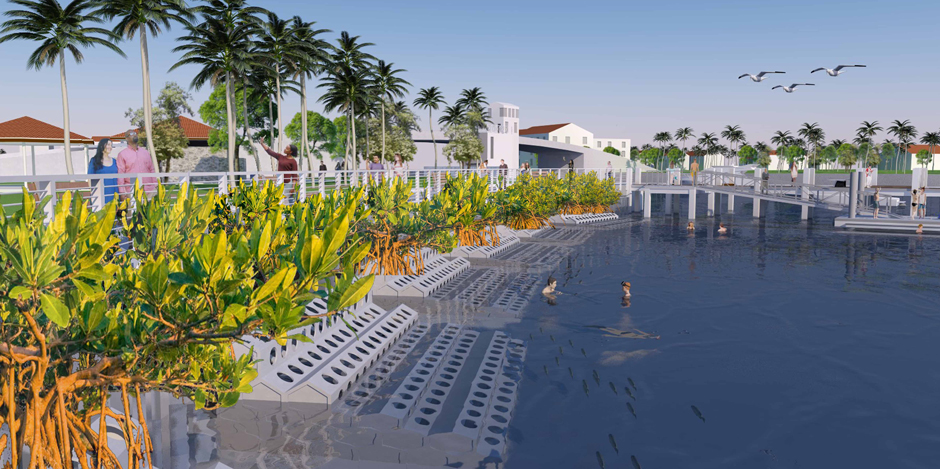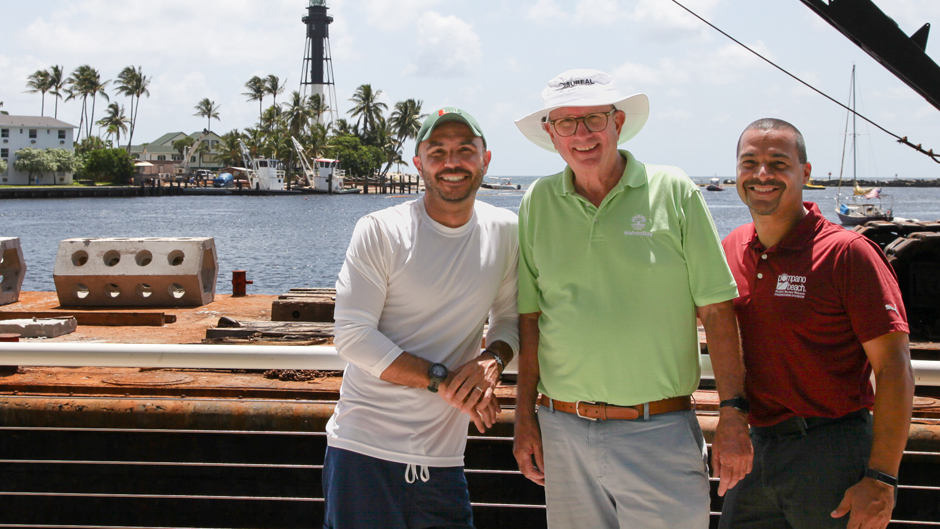In the merciless August heat, associate professor of engineering Landolf Rhode-Barbarigos scaled an incline of honeycomb-shaped concrete tubes hugging the seawall. With a team of divers, he checked to make sure that all the 18-foot units were properly stacked and stable before donning his snorkel mask to make sure they were interlocking underwater, too. The team repeated the process countless times throughout the week.
It's repetitive, but the work is also rewarding for Rhode-Barbarigos. The massive installation marks the realization of an innovation that he and colleagues at the University of Miami have been working on since 2019. At the time, the faculty team was looking for a novel way to prevent coastal erosion—a threat only worsening in a changing climate. Funded by the National Cooperative Highway Research Program, they studied and tested different shapes for slowing waves in the Alfred C. Glassell, Jr. SUSTAIN Laboratory before coming up with the SEAHIVE, a perforated, hexagonal concrete unit, with more durable concrete and reinforcement. It has proven to dissipate strong waves in lab testing. But the SEAHIVE was also designed to allow marine life to thrive in and around it.
“SEAHIVE offers a green-gray solution that may help restore marine ecosystems and protect our coastlines,” said Rhode-Barbarigos, a civil and architectural engineer at the College of Engineering.
After years of planning, SEAHIVE units now stretch across more than 100 feet of the Hillsboro Inlet, in a place called Wahoo Bay Park. Soon, mangroves will be planted to grow out of the concrete structures. And local leaders are hopeful it will soon become a thriving, living laboratory where students can snorkel up and observe a growing shoreline ecosystem. The Wahoo Bay project also offers a test case for a team of researchers from across the University that collaborated as part of a University Laboratory for Integrative Knowledge (U-LINK) project to explore whether this arrangement of SEAHIVE will attract marine life and provide coastal protection.
“Working with the City of Pompano Beach, Broward County, Florida Fish and Wildlife, and Wahoo Bay on a research project is very important for us,” Rhode-Barbarigos added. “To have a space like this codesigned with the community will allow us to showcase potential solutions for the long-term effects of climate change.”
It is not the first time SEAHIVE units have been submerged in the ocean. Last spring, the first SEAHIVE units manufactured at scale were submerged and stacked in a trapezoidal shape off Miami Beach, where they are being studied as a hybrid reef structure. Yet, this week’s installation at Wahoo Bay is the largest one to date. It is also a different concept because the units are stacked against the seawall like a right triangle, as an alternative to traditional wave-break structures. In addition, the U-LINK team will be planting mangroves and seagrass in the units, as part of the effort to create a hybrid, living shoreline.
Rob Wyre leads the nonprofit that is spearheading the effort to create Wahoo Bay Park on submerged land owned by the city of Pompano Beach. The group—called Shipwreck Park—first focused on drawing divers to northern Broward County, but they are now focused on educating younger generations about the importance of marine conservation. To bring Wahoo Bay Park to life, Wyre’s team partnered with the University, as well as the city of Pompano Beach, Broward County, the Florida Fish and Wildlife Conservation Commission, and Florida Atlantic University (FAU).
“We want to raise awareness about the need to protect our natural environments, and our shorelines, and although Wahoo Bay Park was our idea, it’s now a community-wide project,” Wyre said, adding that they have even garnered federal and local grants to support the installation. “Ultimately, we are trying to reach tomorrow’s scientists by exposing them to marine life today.”

Wahoo Bay is also working with FAU to create an educational website about the park, including a livestream camera that will showcase its underwater activity and real-time weather and water quality data captured by instruments in the park. Soon, teachers will be able to bring field trips to the park by making a reservation with the Pompano Beach Parks and Recreation Department, Wyre added.
In the coming weeks, senior researcher Rafael Araújo, along with a team of graduate students from the Rosenstiel School of Marine, Atmospheric and Earth Science will be planting mangrove seedlings and spartina—a plant commonly found along the Atlantic coast—in the top layer of the SEAHIVE units. This will help the University team learn if the combination of human made SEAHIVE with plants will support marine life and offer a stronger buffer to the coast during storms.
Araújo is already confident about their success. In two years, he believes the Wahoo Bay SEAHIVE structures will be covered in sponges, barnacles and algae, and will attract many species of fish, turtles, and manatees. However, it is the first time he has done this type of mangrove restoration.
“There aren’t many examples of this worldwide, so it’s quite a unique initiative,” said Araújo, an international expert on mangroves. “It’s exciting and a little terrifying because its nature, which is unpredictable. It will likely require modifications, and we need to be prepared to learn. But this is a very dynamic area, so we expect to see a lot of marine life recruiting to the structures.”

And while the research is just starting, Wyre and officials with the City of Pompano Beach are optimistic about the future.
“This is definitely going to be one of the city’s hidden jewels,” said Hector Gandia, project manager for the City of Pompano Beach engineering department.
After the first section of SEAHIVE were installed in March, local residents have already noticed more fish in the area. Dean Pazin, a charter fisherman who drives through the Hillsboro Inlet to reach the ocean, said he has watched the seagrasses, fish and shellfish in the area diminish in the past decade. He believes the new installation will help reverse the harmful trend.
“This used to be a place for good baitfish migration, but lately the seagrass beds have been destroyed,” said Pazin, a nearby Pompano Beach resident. “If we can get more baitfish back, it will help restore the entire ecosystem.”

